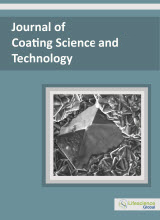jcst
|
|
|
Abstract: In this study, the use of sol-gel/epoxy adhesive based on the combination of organic and inorganic components within the adhesive matrix have been studied. The combination of different amounts of ᵞ-Al2O3 nano-particles to the adhesive matrix was evaluated. Mild steel specimens were prepared for lap joints, which were cured in an oven at 200°C for 16 hours. The bond strength of the sol-gel/epoxy matrix was investigated using a universal tensile test machine. The presence of Al-OH and/or Si-OH bonds increases causing an increase in the strength of the bulk material. This process is seen through the appearance of an absorption peak shoulder which appears in the range of ~ 1088 to1100cm-1 which corresponds to Al-O-Si or Si-O-Si. The maximum adhesive strength of composite sol-gel/epoxy adhesive recorded was 23±0.4MPa. This was obtained when small amounts of γ-Al2O3 nano-particles (4.0 wt%), were incorporated within the matrix. However, as the level of these inorganic materials in the adhesive matrix increased further, the adhesive shear strength gradually decreased. At a high ratio of γ-Al2O3 particles, poor interfacial bonding or adhesion between the filler and the adhesive matrix is recorded. Scanning Electron Microscopy (SEM) is used to investigate the fracture surface with 4.0 wt% γ-Al2O3, the scanning shows a very small distance of cracks, suggesting the material may act as a barrier to crack propagation and thus increases the energy required for fracture. Keywords: γ-Al2O3 Nano-Particles, Sol-Gel/Epoxy, Adhesive Strength. |
|
|
|
Abstract: In this work, pyrene labeled polystyrene (PS) latex dispersions and silver nanoparticles (AgNPs) were mixed at different weight ratios of AgNPS in the range of 0-50 wt%. Powder (PS/AgNPs) films were prepared on glass substrates from these mixtures by the drop-casting method at room temperature. The fast transient fluorescence (FTRF) technique was used to monitor the film formation process of PS/AgNPs composites by measuring the fluorescence lifetimes of pyrene during vapor exposure. It was observed that pyrene lifetimes decreased as vapor exposure time, t increased obeying Stern–Volmer kinetic. The optical transmission (UVV) experiments showed that the transparency of the films decreased with increasing AgNPs content. Transparent films were produced for the composites with 0 to 20 wt % of AgNPs content. The Prager–Tirrel model was employed to FTRF and UVV data to obtain back-and-forth frequencies, ν, of the reptating PS chains during vapor induced film formation process and polymer interdiffusion was found to obey a t1/2 law. Despite the conductivity increased by 3 orders of magnitude with increasing AgNPs content, the composites behaved like an insulator. The morphology of composite films also progressively changed during vapor exposure and affected by AgNPs content. Keywords: Polystyrene, Silver Nanoparticles, Films, Coatings, Solvent Vapor, Latex. |
|
|
|
Abstract: : Microwave plasma CVD growth can produce black and white varieties of polycrystalline diamond (PCD), depending on their as-grown purity. These two types of PCDs have been polished by mechanical and chemo-mechanical polishing respectively. It has been observed that initial roughness of 2.21μm for white PCD can be brought down to 175 nm after 70 hours of combined polishing, whereas, 85 hours of combined polishing could bring down the high initial roughness of 11.2μm for black PCD down to 546 nm at the end. Although, the material that was removed during polishing was higher for the black variety of PCD but it had lower polishing rate of 4nm/hr than white PCD (13nm/hr) during chemo-mechanical polishing. Such differential polishing rate was due to harder top polished surface of the black diamond than the white diamond. The nanoindentation study on the polished PCD surfaces revealed that the black PCD has a final nanohardness of 32.58±1 GPa whereas the white variety PCD had a polished surface nanohardness of 28.5±2 GPa. More conversion of diamond surface into harder amorphous sp3 than softer graphite during polishing action may have resulted such slow rate of anisotropic polishing for black diamond than white diamond. Keywords: Microwave plasma CVD, Polycrystalline diamond, Polishing, Diamond quality, Nanohardness. |
|
|
|
Abstract: : Titanium carbonitride thin films were grown by reactive magnetron sputtering deposition of titanium carbide target in Ar/N2 gas mixture on p-type silicon (100) substrates. With the increase of sputtering power up to 125W, the deposition rate and films thickness reached a maximum of 14nm/min and 430nm, respectively. A thick film of about 2200nm could be deposited for 120 min at the optimum deposition pressure of 20mTorr. Cathode current decreased from about 290mA to reach a value of about 235mA as the N2 flow percentage increased from 0 to 100%. X-ray diffraction analyses of the deposited films confirmed the formation of titanium carbide and carbonitride layers as the nitrogen gas concentrations in the process gas were increased. SEM image of the deposited titanium carbonitride thin film for 5 min deposition time showed that the film started to grow as tiny particles of size as low as about 140nm, which in later stage coalesced together to form bigger grains and finally a continuous film. The deposited film shows good thermal stability upon annealing in air and in vacuum at 700oC for 2 hours. Keywords: Titanium carbonitride, Nanocomposite thin films, Reactive magnetron sputtering, Thermal stability. |
|
|
|
Keywords: Core-Shell, Titanium Dioxide, Latex, Opacity, Paint. |


